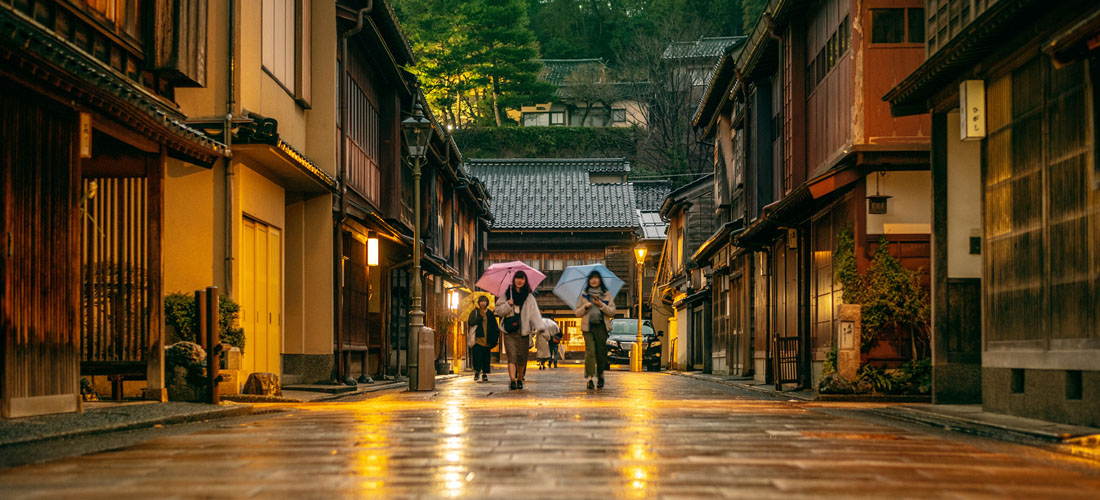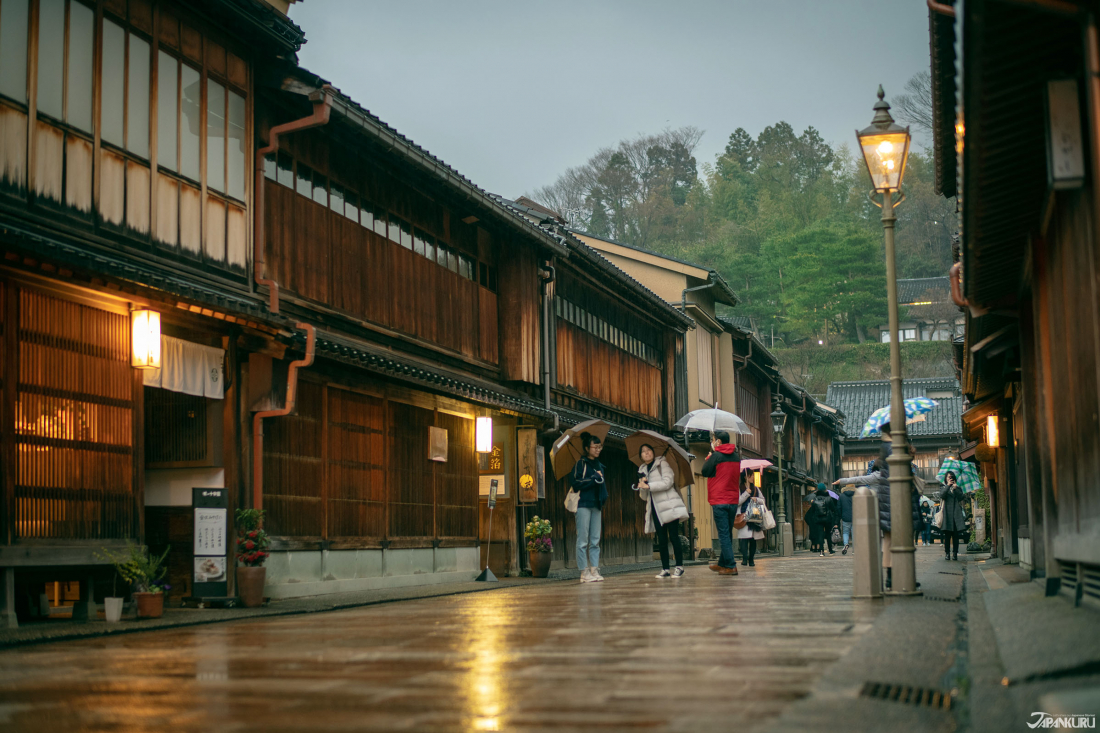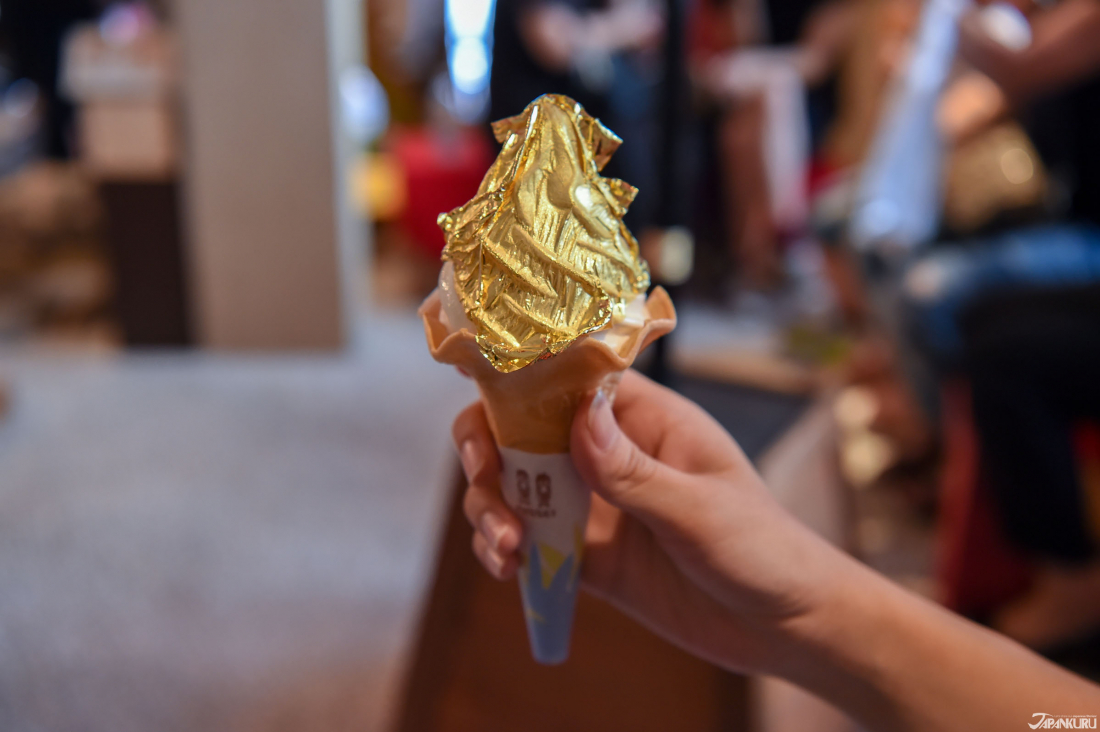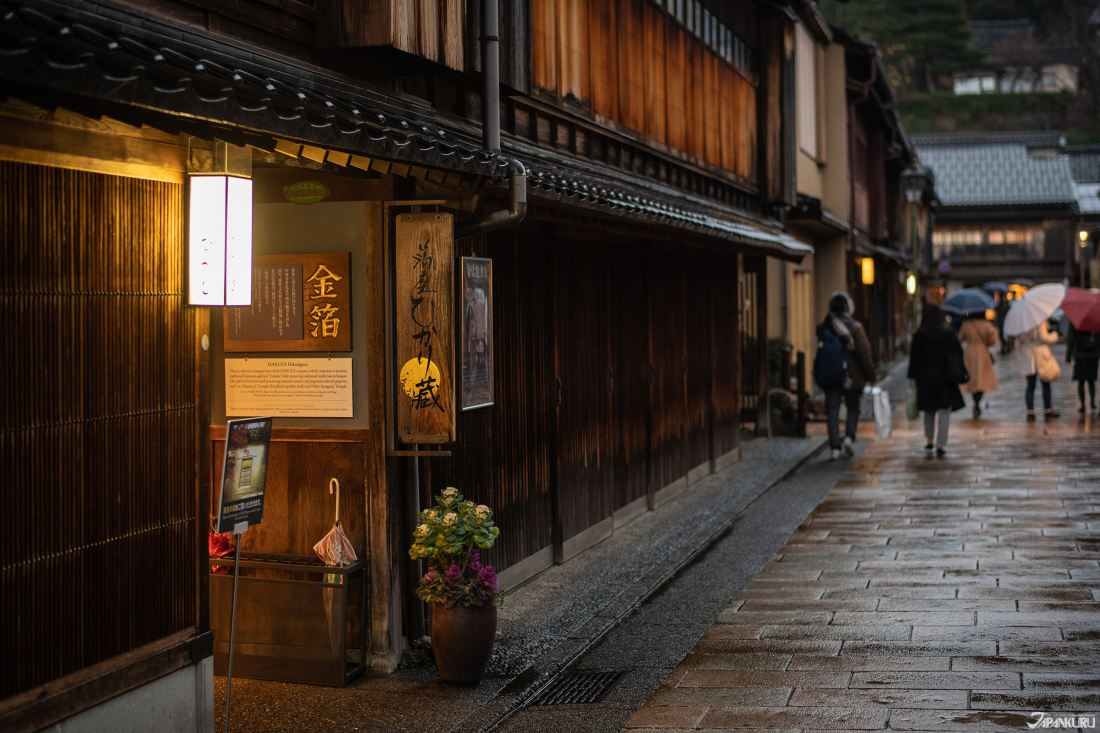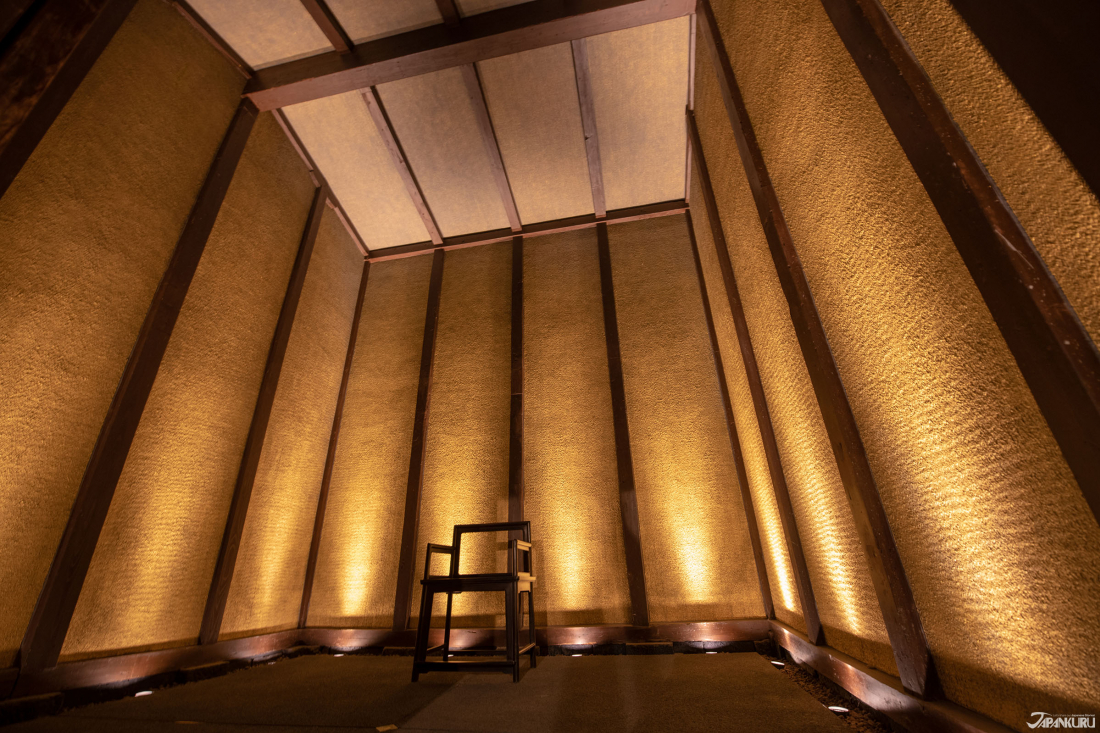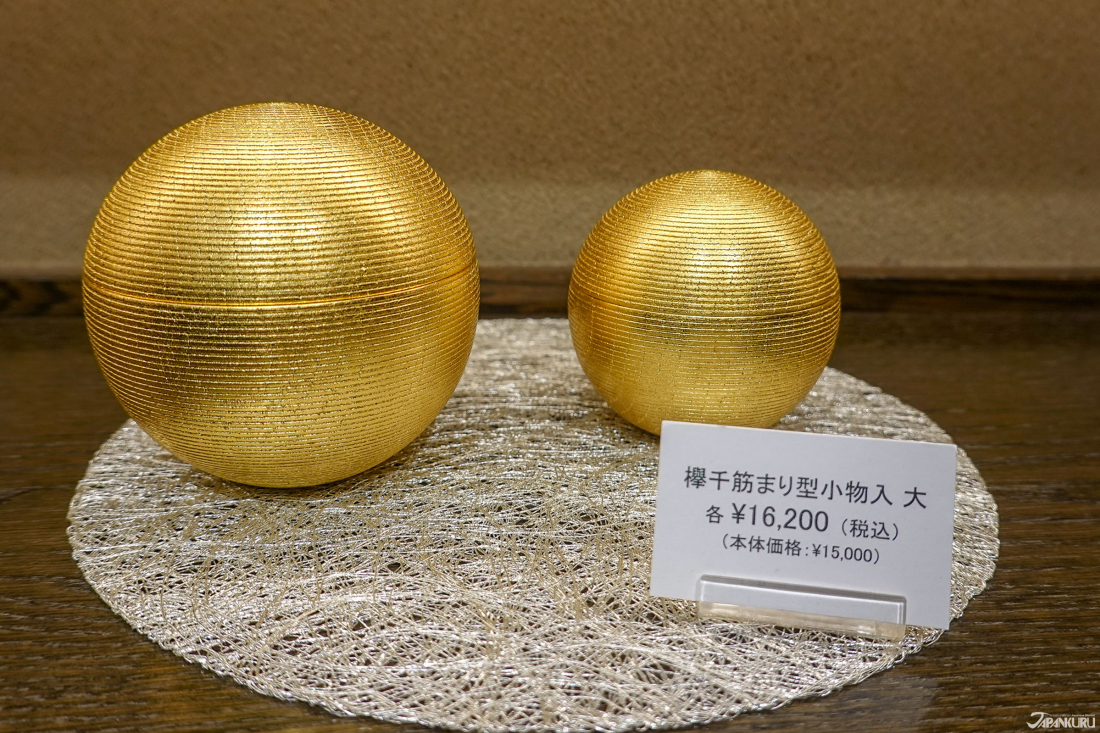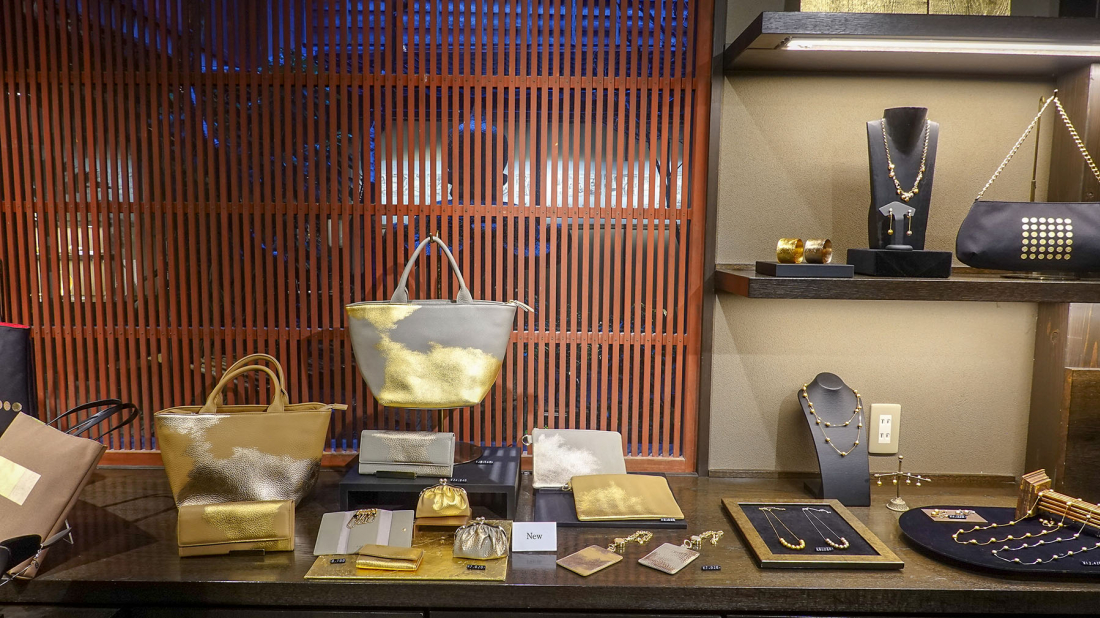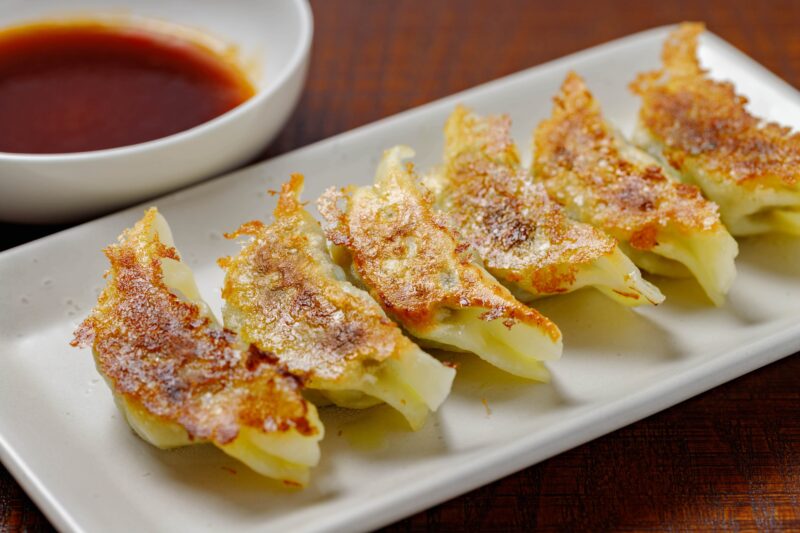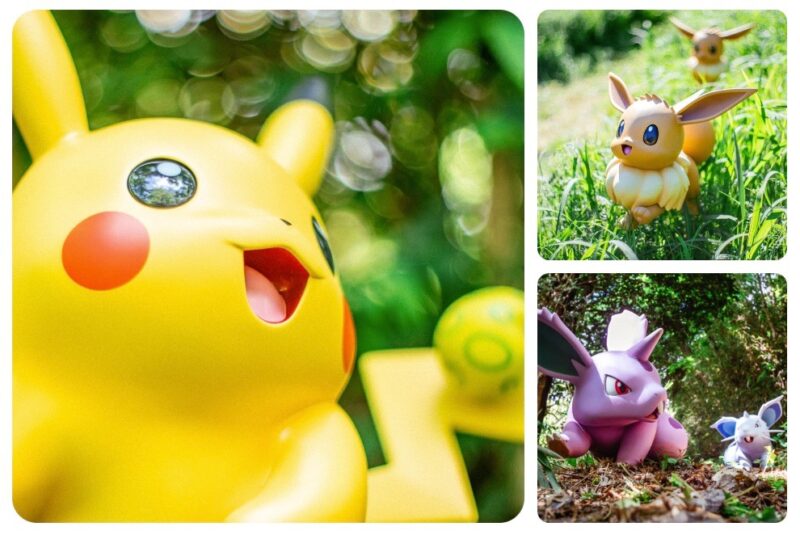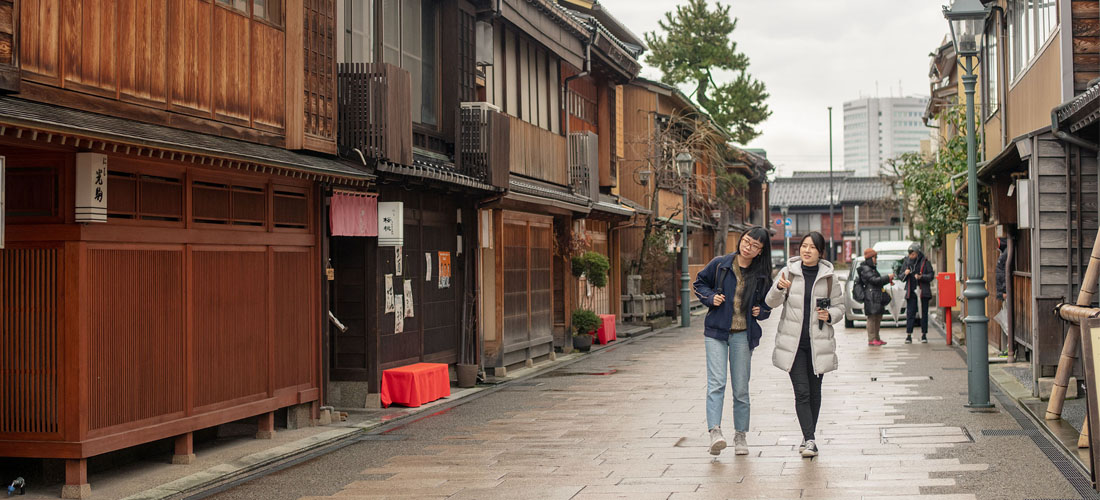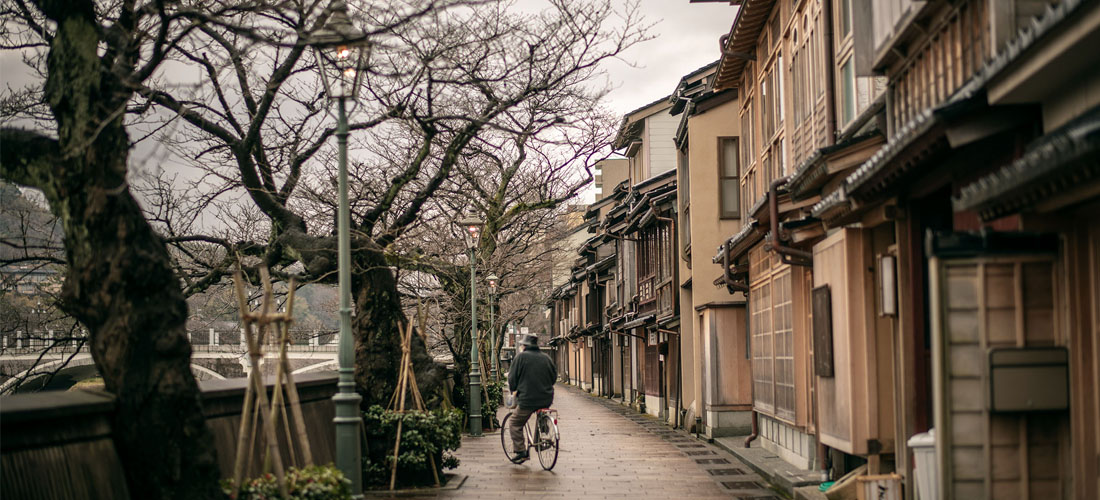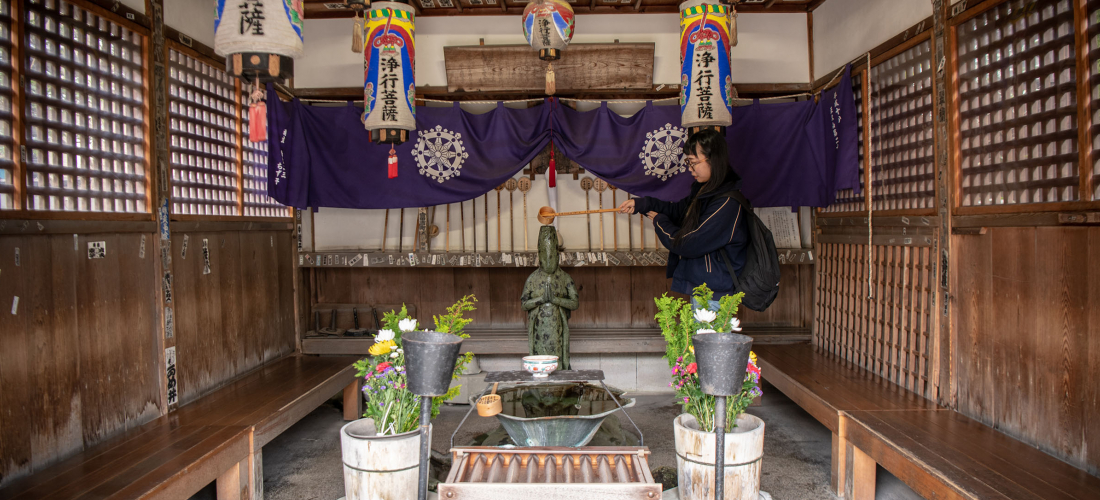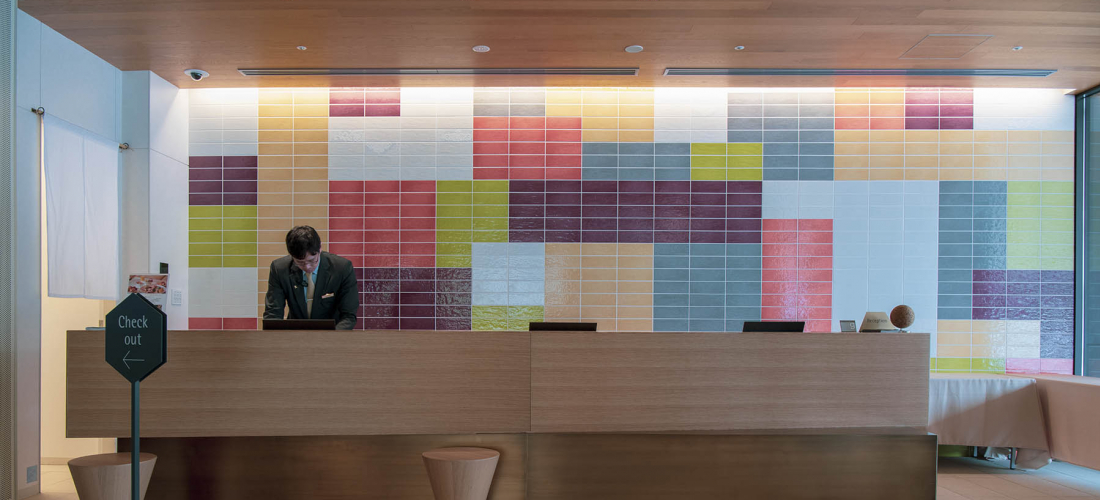With the current popularity of Tokyo and Kyoto, first-time visitors to Japan often overlook Kanazawa when planning their trips—though locals and savvy visitors alike are well aware of the immense value in making a stop in Ishikawa Prefecture's capital city. Originally founded as a castle town by the Maeda-clan in the late 16th century, Kanazawa (which translates to "Marsh of Gold") has a plethora of well-known attractions one should be sure to check out when visiting. Among the more notable areas to visit are its well-preserved chaya districts, or "tea house streets" found near the downtown area and along the Asano river. These districts originated during the Edo-era, are incredibly well-preserved, and are highlighted by their sleek, wooden architectural designs and stone-paved streets. These unique areas—now labeled as Japanese cultural assets—mainly served as places of entertainment where locals would dine, drink, and take in geisha performances. It's important to note that these chaya districts are actually divided into three main areas: the largest and most popular, Higashi Chaya-gai (Eastern Tea House Street), Nishi Chaya-gai (Western Tea House Street), and Kazue-machi Chaya (named after a Kaga region samurai clan).
Higashi-Chaya: Explore Kanazawa’s Largest Tea House Street and Prosperous Past
Higashi Chaya-gai is the largest, and most popular of the chaya districts in Kanazawa, exhibiting a well preserved, Edo-era feel for which the area is famous. These districts are typically lined by two-story buildings utilizing a red, wooden lattice design (known as "kimusuko" in Japanese), which generally are found lining the building's first-floor exterior where guests would dine and be entertained, while traditional, more private guest rooms are located on the second floor. Given their close proximity to the streets and a desire for privacy, discretion was baked into the exterior lattice design, which afforded guests a view of the outside while simultaneously blocking outsiders from peeking in. Though one can find this design throughout other nearby cities such as Kyoto, the displays on offer throughout Kanazawa's chaya districts are prime examples of the style, and are not to be missed!
Among the most famous of Higashi Chaya's tea houses are the Kaikaro Geisha Teahouse, which still functions as a fully operational geisha house today (and is the largest of its kind in Kanazawa), and the Ochaya Shima Geisha Teahouse, now a nationally designated Important Cultural Asset of Japan. Both tea houses are open to the public during daytime hours for visitors to explore these traditional spaces and learn how geisha entertain their guests through the use of music, poetry, singing, and drinking games. Both are inaccessible at night, however, given Ochaya Shima Geisha Teahouse now primarily functions as a museum, and Kaikaro Geisha Teahouse entertains wealthy clientele during the evening on an invitation-only basis. Should you wish you to have an authentic experience though, Kaikoro does provide special plans where visitors can experience a traditional meal accompanied by geisha performances, though they do not offer the full range of entertainment options typically offered to patrons. Please refer to their website here for more details, though be aware all information is listed in Japanese.
Kanazawa's translated namesake as the "Marsh of gold" is an apt description, considering 99% of Japan's "gold leaf foil" originates from the area. To see some of the best examples of products on display making use of the famed gold leaf, we stopped by Hakuza in Higashi Chaya (also known as the "Golden Warehouse") to see some of the incredible golden craftsmanship on offer, which includes a tea room modeled after an original used by Toyotomi Hideyoshi—a 16th-century feudal warlord known for unifying Japan. The building itself incorporates gold leaf foil throughout its design, as you will find some of the building's outer and inner walls completely covered in this extremely thin, yet mesmerizingly beautiful material. Entry to the building is free for all to view, which also incorporates a shop selling a wide range of gold leaf foil products such as lacquerware, foods, cosmetics, and other miscellaneous goods.
While strolling through the chaya streets of today you'll find the two-story buildings are no longer solely operating as geisha tea houses entertaining private guests, but have been converted to shops selling a wide range of products and services like fresh foods and fruits, confectionaries, coffee, cosmetics, kimono rentals, and much more! Outside of the ever-present opportunities to purchase a delicious snack, sweet, or keepsake—no matter the season or weather—while strolling through this quaint district one is transported back in time and afforded a glimpse of the daily life of past generations dating back to the Edo-era. We hope you'll find it as enjoyable as we do, and be sure to drop by next time you are in Kanazawa!
Be sure to look at JAPANKURU🐶 for more exciting articles every day!!
Or add us on Instagram and Facebook to share your Japanese pictures💖🗾
Details
NAME:Higashi-Chaya (ひがし茶屋街)
MAP
1-13 Higashiyama, Kanazawa, Ishikawa
CONTACT TEL:076-220-2194
COMMENT
FEATURED MEDIA
VIEW MORE 
A New Tokyo Animal Destination: Relax & Learn About the World’s Animals in Japan
#pr #japankuru #anitouch #anitouchtokyodome #capybara #capybaracafe #animalcafe #tokyotrip #japantrip #카피바라 #애니터치 #아이와가볼만한곳 #도쿄여행 #가족여행 #東京旅遊 #東京親子景點 #日本動物互動體驗 #水豚泡澡 #東京巨蛋城 #เที่ยวญี่ปุ่น2025 #ที่เที่ยวครอบครัว #สวนสัตว์ในร่ม #TokyoDomeCity #anitouchtokyodome

Shohei Ohtani Collab Developed Products & Other Japanese Drugstore Recommendations From Kowa
#pr #japankuru
#kowa #syncronkowa #japanshopping #preworkout #postworkout #tokyoshopping #japantrip #일본쇼핑 #일본이온음료 #오타니 #오타니쇼헤이 #코와 #興和 #日本必買 #日本旅遊 #運動補充能量 #運動飲品 #ช้อปปิ้งญี่ปุ่น #เครื่องดื่มออกกำลังกาย #นักกีฬา #ผลิตภัณฑ์ญี่ปุ่น #อาหารเสริมญี่ปุ่น

도쿄 근교 당일치기 여행 추천! 작은 에도라 불리는 ‘가와고에’
세이부 ‘가와고에 패스(디지털)’ 하나면 편리하게 이동 + 가성비까지 완벽하게! 필름카메라 감성 가득한 레트로 거리 길거리 먹방부터 귀여움 끝판왕 핫플&포토 스폿까지 총집합!
Looking for day trips from Tokyo? Try Kawagoe, AKA Little Edo!
Use the SEIBU KAWAGOE PASS (Digital) for easy, affordable transportation!
Check out the historic streets of Kawagoe for some great street food and plenty of picturesque retro photo ops.
#pr #japankuru #도쿄근교여행 #가와고에 #가와고에패스 #세이부패스 #기모노체험 #가와고에여행 #도쿄여행코스 #도쿄근교당일치기 #세이부가와고에패스
#tokyotrip #kawagoe #tokyodaytrip #seibukawagoepass #kimono #japantrip

Hirakata Park, Osaka: Enjoy the Classic Japanese Theme Park Experience!
#pr #japankuru #hirakatapark #amusementpark #japantrip #osakatrip #familytrip #rollercoaster #retrôvibes #枚方公園 #大阪旅遊 #關西私房景點 #日本親子旅行 #日本遊樂園 #木造雲霄飛車 #히라카타파크 #สวนสนุกฮิราคาตะพาร์ค

🍵Love Matcha? Upgrade Your Matcha Experience With Tsujiri!
・160년 전통 일본 말차 브랜드 츠지리에서 말차 덕후들이 픽한 인기템만 골라봤어요
・抹茶控的天堂!甜點、餅乾、飲品一次滿足,連伴手禮都幫你列好清單了
・ส่องมัทฉะสุดฮิต พร้อมพาเที่ยวร้านดังในอุจิ เกียวโต
#pr #japankuru #matcha #matchalover #uji #kyoto #japantrip #ujimatcha #matchalatte #matchasweets #tsujiri #말차 #말차덕후 #츠지리 #교토여행 #말차라떼 #辻利抹茶 #抹茶控 #日本抹茶 #宇治 #宇治抹茶 #日本伴手禮 #抹茶拿鐵 #抹茶甜點 #มัทฉะ #ของฝากญี่ปุ่น #ชาเขียวญี่ปุ่น #ซึจิริ #เกียวโต

・What Is Nenaito? And How Does This Sleep Care Supplement Work?
・你的睡眠保健品——認識「睡眠茶氨酸錠」
・수면 케어 서플리먼트 ‘네나이토’란?
・ผลิตภัณฑ์เสริมอาหารดูแลการนอน “Nenaito(ネナイト)” คืออะไร?
#pr #japankuru #sleepcare #japanshopping #nenaito #sleepsupplement #asahi #睡眠茶氨酸錠 #睡眠保健 #朝日 #l茶胺酸 #日本藥妝 #日本必買 #일본쇼핑 #수면 #건강하자 #네나이토 #일본영양제 #อาหารเสริมญี่ปุ่น #ช้อปปิ้งญี่ปุ่น #ร้านขายยาญี่ปุ่น #ดูแลตัวเองก่อนนอน #อาซาฮิ

Japanese Drugstore Must-Buys! Essential Items from Hisamitsu® Pharmaceutical
#PR #japankuru #hisamitsu #salonpas #feitas #hisamitsupharmaceutical #japanshopping #tokyoshopping #traveltips #japanhaul #japantrip #japantravel

Whether you grew up with Dragon Ball or you just fell in love with Dragon Ball DAIMA, you'll like the newest JINS collab. Shop this limited-edition Dragon Ball accessory collection to find some of the best Dragon Ball merchandise in Japan!
>> Find out more at Japankuru.com! (link in bio)
#japankuru #dragonball #dragonballdaima #animecollab #japanshopping #jins #japaneseglasses #japantravel #animemerch #pr

This month, Japankuru teamed up with @official_korekoko to invite three influencers (originally from Thailand, China, and Taiwan) on a trip to Yokohama. Check out the article (in Chinese) on Japankuru.com for all of their travel tips and photography hints - and look forward to more cool collaborations coming soon!
【橫濱夜散策 x 教你怎麼拍出網美照 📸✨】
每次來日本玩,是不是都會先找旅日網紅的推薦清單?
這次,我們邀請擁有日本豐富旅遊經驗的🇹🇭泰國、🇨🇳中國、🇹🇼台灣網紅,帶你走進夜晚的橫濱!從玩樂路線到拍照技巧,教你怎麼拍出最美的夜景照。那些熟悉的景點,換個視角說不定會有新發現~快跟他們一起出發吧!
#japankuru #橫濱紅磚倉庫 #汽車道 #中華街 #yokohama #japankuru #橫濱紅磚倉庫 #汽車道 #中華街 #yokohama #yokohamaredbrickwarehouse #yokohamachinatown

If you’re a fan of Vivienne Westwood's Japanese designs, and you’re looking forward to shopping in Harajuku this summer, we’ve got important news for you. Vivienne Westwood RED LABEL Laforet Harajuku is now closed for renovations - but the grand reopening is scheduled for July!
>> Find out more at Japankuru.com! (link in bio)
#japankuru #viviennewestwood #harajuku #omotesando #viviennewestwoodredlabel #viviennewestwoodjapan #비비안웨스트우드 #오모테산도 #하라주쿠 #日本購物 #薇薇安魏斯伍德 #日本時尚 #原宿 #表參道 #japantrip #japanshopping #pr

Ready to see TeamLab in Kyoto!? At TeamLab Biovortex Kyoto, the collective is taking their acclaimed immersive art and bringing it to Japan's ancient capital. We can't wait to see it for ourselves this autumn!
>> Find out more at Japankuru.com! (link in bio)
#japankuru #teamlab #teamlabbiovortex #kyoto #kyototrip #japantravel #artnews
Photos courtesy of teamLab, Exhibition view of teamLab Biovortex Kyoto, 2025, Kyoto ® teamLab, courtesy Pace Gallery

Japanese Makeup Shopping • A Trip to Kamakura & Enoshima With Canmake’s Cool-Toned Summer Makeup
#pr #canmake #enoshima #enoden #에노시마 #캔메이크 #japanesemakeup #japanesecosmetics

⚔️The Robot Restaurant is gone, but the Samurai Restaurant is here to take its place. Check it out, and don't forget your coupon!
🍣신주쿠의 명소 로봇 레스토랑이 사무라이 레스토랑으로 부활! 절찬 쿠폰 발급중
💃18歲以上才能入場的歌舞秀,和你想的不一樣!拿好優惠券去看看~
#tokyo #shinjuku #samurairestaurant #robotrestaurant #tokyotrip #도쿄여행 #신주쿠 #사무라이레스토랑 #이색체험 #할인이벤트 #歌舞伎町 #東京景點 #武士餐廳 #日本表演 #日本文化體驗 #japankuru #japantrip #japantravel #japanlovers #japan_of_insta

Japanese appliance & electronics shopping with our KOJIMA x BicCamera coupon!
用JAPANKURU的KOJIMA x BicCamera優惠券買這些正好❤️
코지마 x 빅 카메라 쿠폰으로 일본 가전 제품 쇼핑하기
#pr #japankuru #japanshopping #kojima #biccamera #japaneseskincare #yaman #dji #osmopocket3 #skincaredevice #日本購物 #美容儀 #相機 #雅萌 #日本家電 #일본여행 #면세 #여행꿀팁 #일본쇼핑리스트 #쿠폰 #일본쇼핑 #일본브랜드 #할인 #코지마 #빅카메라 #japankurucoupon
MAP OF JAPAN
SEARCH BY REGION

LATEST
VIEW MOREEVENT CALENDAR
VIEW MORE





